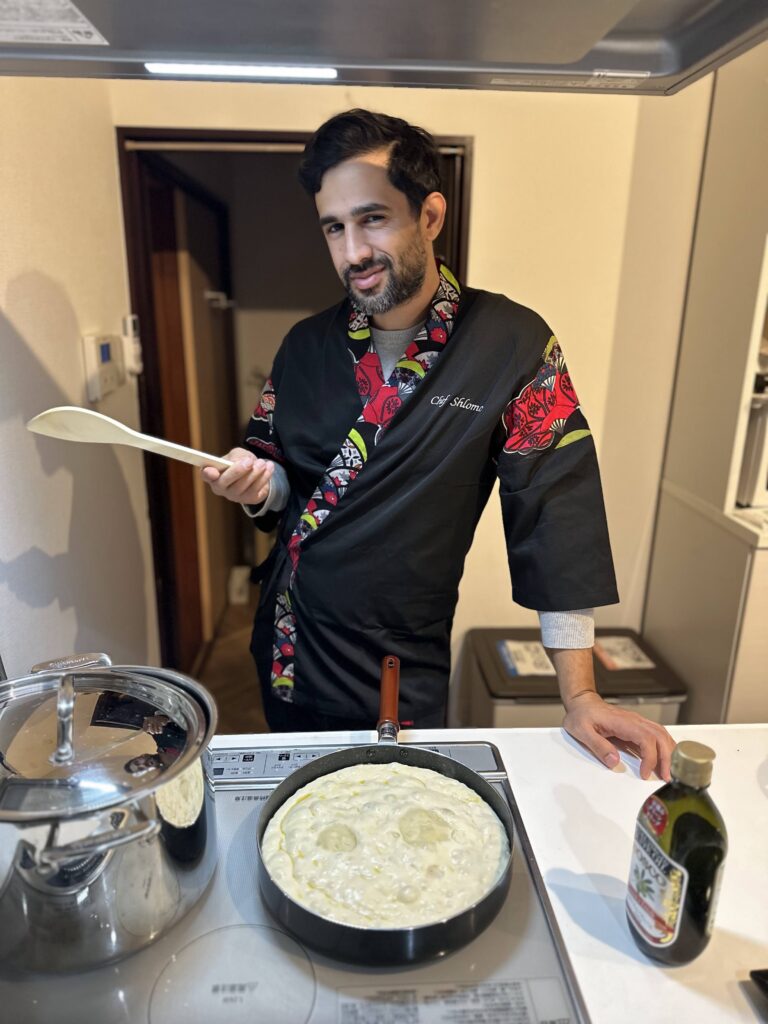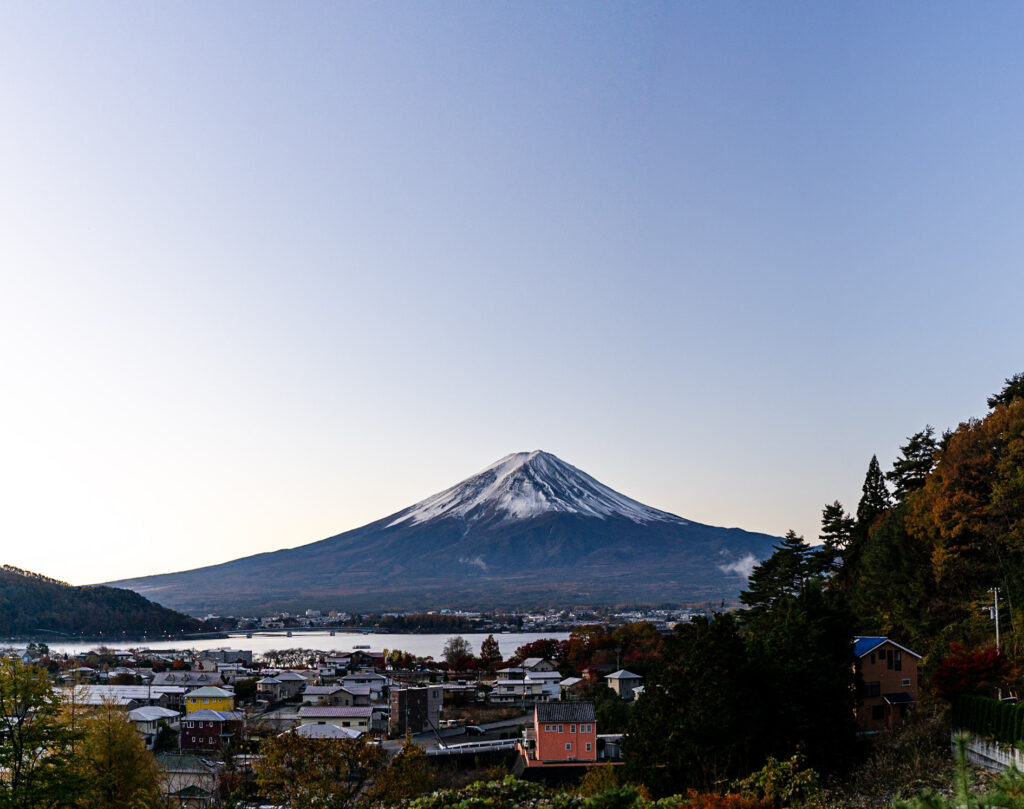(Disclosure: Author of this article is related to Dani Klein of YeahThatsKosher)
In November 2024, I co-ran a trip with Omakase Kosher Tours (now my wife!) for a Thanksgiving trip to Japan. We explored Tokyo, Kyoto, Mount Fuji, and plenty of breathtaking spots in between. But here’s the challenge: kosher food in Japan is scarce and expensive when you do find it. To make our trip affordable and practical, I volunteered to cook three meals a day for our group of eight. At first, it sounded intimidating, but it turned out to be both doable and memorable. If you’re planning your own trip, here’s how you can make kosher cooking in Japan work for you.
Getting Set Up: Equipment & Essentials
MMost Japanese Airbnbs don’t have ovens, only stovetops, often induction. That means a good frying pan and pot will be your workhorses. We picked some up locally (and donated them at the end), but you can bring your own if you want to start cooking right away. Just make sure they’re induction-compatible. I’d also recommend practicing new recipes at home before your trip so you’re confident cooking under travel conditions.
We also packed some key kosher items that are nearly impossible to find in Japan:
- Yeast (for focaccia)
- Kosher-certified seaweed (flat, easy to pack)
For everything else, vegetables, rice, eggs, plain pasta, and even certain soy sauce or olive oils, you can shop in Japan, but check with your rabbi beforehand about what’s acceptable without a hechsher.
What We Cooked
Cooking for eight meant we had to prep daily, sometimes more than once. But with a little planning, meals came together smoothly. Below is a list of all the foods we cooked in Japan. You can look up simple recipes for most of these, and the more niche ones are described below.
Salads
Fresh, easy, and endlessly customizable. Lettuce, cabbage, parsley, tomatoes, cucumbers, peppers, and onions are widely available. Dress simply with lemon juice, olive oil, and salt. We alternated between a basic mixed salad and a chopped Israeli-style salad to keep things interesting.
Carbs
- Focaccia: With no oven, I pan-fried focaccia almost daily. Mixing the dough the night before meant warm bread for breakfast. See recipe below.
- Pasta: Japan sells plain pasta, which doesn’t need a hechsher. A drizzle of olive oil, soy sauce, or homemade marinara goes a long way.
- Rice: Very simple once you get the water ratio right. A kitchen scale helps.
- Potatoes: Peeled, cubed, boiled, then tossed with olive oil, salt, and pepper.
Proteins
- Eggs: A lifesaver. We hard-boiled dozens at a time for on-the-go lunches. Egg salad with olive oil, salt, and pepper tasted even better in Japan.
- Fish: Fresh salmon is easy to find. Pan-fry with salt, pepper, or soy sauce. Pair with rice and seaweed (brought from home) for simple sushi handrolls.
- Special treat: One night, we made shakshuka with onions, peppers, tomatoes, and eggs simmered together. Comfort food, even in Japan.
Dessert
We mostly kept it simple with fresh fruit from local markets.
Tools & Ingredients Checklist
If you’re cooking kosher in Japan, here’s a handy list to pack or buy. I included budget picks if you just need it for the trip, and premium picks if you want quality items for long-term use.
Tools
Food Items to Pack
Ingredients to Buy Locally
- Pasta
- Fresh vegetables (lettuce, cabbage, parsley, tomatoes, cucumbers, peppers, onions, scallions, avocado)
- Eggs
- Rice
- Potatoes
- Fish
- Flour, salt, pepper
- Lemons
Where to Shop in Japan
Local stores and markets have everything you need for fresh produce and basic kitchenware.
Use Google Maps with these search terms:
- Supermarket: スーパーマーケット
- 100 yen shop (great for utensils): 100円ショップ
You can also search Daiso (in English) for inexpensive kitchen and travel items.
Recipes
Salad Dressing
Tools needed
Ingredients
- 2 parts extra virgin olive oil
- 1 part freshly squeezed lemon juice
- Salt to taste
Directions
Combine all ingredients in a bowl or jar. Whisk or shake until blended.
Focaccia
Tools needed
Ingredients
- 500 grams flour
- 325 grams water
- 5 grams yeast
- 10 grams salt
- 15 grams olive oil
Directions
Place all ingredients in a bowl and mix by hand until well combined. In a separate bowl, swirl a small amount of olive oil to coat the sides. Transfer the dough to this bowl, making sure all sides are coated, including the top. Let the dough rise for several hours or overnight. When ready to cook, pour some olive oil in a pan and gently pour in the dough. Let stand for about 10 minutes to let the dough spread out. Cook for about 10 minutes, depending on thickness, until the bottom is browned. Flip carefully with a spatula and cook for about another 10 minutes. Remove from the pan, slice, and serve warm.
Soy Pasta
Tools needed
Ingredients
- 1 package pasta
- ¼ cup soy sauce
- 5 to 7 scallions, sliced
- 2 tablespoons olive oil
- Garlic powder to taste
Directions
Cook pasta according to package instructions (use Google Translate if needed). Drain and let cool slightly. Return pasta to the pot, add the soy sauce, scallions, olive oil, and garlic powder, and mix until well combined.
Rice
Tools needed
Ingredients
Directions
Place rice in a bowl and cover with water. Add a pinch of salt and let soak for 30 minutes. Drain completely and transfer to a pot on a scale. Note the weight of the rice and add water equal to 1.1 times its weight. Bring to a boil, then cover and reduce to a simmer for about 15 minutes. Allow to cool before serving.
Egg Salad
Tools needed
Ingredients
- 4 hard boiled eggs
- 1 tablespoon olive oil
- Salt and pepper to taste
Directions
Mash the eggs in a bowl using a fork. Add olive oil, salt, and pepper, then mix until smooth.
Fried Salmon
Tools needed
Ingredients
- Salmon
- Salt and pepper to taste
Directions
Heat a frying pan until hot. Place the salmon in the pan and cook until done, flipping as needed. Season with salt and pepper.
Sushi Handrolls
Tools needed
Ingredients
- Cooked fish
- Cooked rice
- Seaweed
- Vegetables of choice
- Soy sauce for dipping optional
Directions
Cut a sheet of seaweed in half. Spread a thin layer of cooled rice on one side. Add fish and vegetables on top of the rice. Roll the seaweed into a cone shape, using the bottom halfway point as the anchor.
Final Thoughts
Cooking kosher in Japan sounds daunting, but with a little planning, it’s surprisingly manageable and even fun. Some of my best memories from the trip are gathered around the Airbnb table, sharing fresh focaccia and sushi handrolls we made ourselves. It turned the challenge of keeping kosher abroad into part of the adventure.








